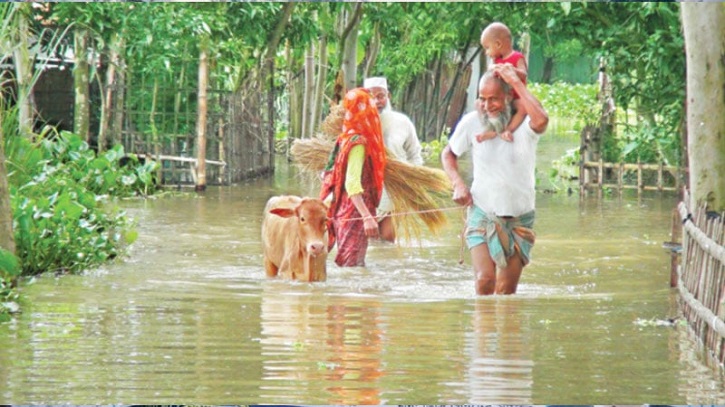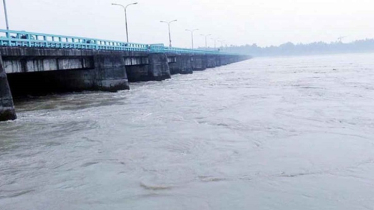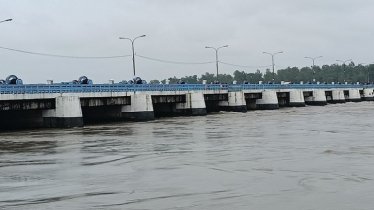
Heavy rainfall and upstream water surges have caused the Teesta River to overflow its banks, triggering floods across Rangpur, Lalmonirhat, Nilphamari, and Kurigram districts. Thousands of residents in low-lying riverine areas have been marooned, while vast tracts of transplanted Aman paddy, vegetables, and mung bean fields remain submerged.
According to the Flood Forecasting and Warning Centre (FFWC) of the Water Development Board, although the Teesta’s water level started receding slightly since Monday morning, it is still flowing above the danger mark. The center projected that water levels in the Teesta, Dharla, and Dudhkumar rivers may begin to fall over the next three days, offering some relief from the ongoing flood situation.
As the Teesta’s water level rose sharply, the Water Development Board issued a red alert. On Sunday night, the river at the Teesta Barrage point—Bangladesh’s largest irrigation project—was flowing 36 centimeters above the danger level of 52.15 cm. The overflowing water inundated the downstream areas of Gangachara and Kaunia in Rangpur, as well as parts of Lalmonirhat and Kurigram. By Monday evening, however, the water level had dropped to 25 centimeters below the danger mark.
In Gangachara upazila alone, seven unions have been severely affected, with about 4,000 families trapped by floodwaters. Many residents have moved their belongings, furniture, and livestock to higher ground. The Water Development Board had earlier issued flood warnings, urging people to seek safety, while the upazila administration broadcast alerts through loudspeakers. Despite these warnings, homes in several unions—including Nohali, Alambiditor, Kolkond, Lakshmitari, Gajghanta, and Mornaya—were inundated, leaving thousands of families stranded.
Gangachara Upazila Nirbahi Officer Mahmud Hasan Mridha said that 12 tons of rice had been allocated as relief for affected families.
Meanwhile, a sudden storm accompanied by continuous rainfall since Sunday morning damaged more than 700 houses in Alambiditor and Nohali unions of Gangachara. Tin-roofed and semi-pucca homes collapsed, trees were uprooted, and residents were seen drying wet books and clothes while cooking in open spaces. Local authorities have distributed dry food and allocated eight tons of rice for the victims.
In Lalmonirhat, nearly 5,000 families have been marooned across the low-lying areas of Patgram, Hatibandha, Kaliganj, Aditmari, and Sadar upazilas. Executive Engineer of the Water Development Board, Sunil Kumar, said preparations were underway to prevent riverbank erosion. Deputy Commissioner H. M. Rakib Haydar stated that adequate relief and dry food supplies were stocked and ready for distribution.
In Kurigram, thousands of tree trunks were seen floating down the Brahmaputra and Dudhkumar rivers in Chilmarhi, Nageshwari, and Bhurungamari upazilas. Locals were collecting the logs using boats and ropes. It is suspected that the trees were uprooted by strong currents in Bhutan’s Kaljani and India’s Hasimara forest regions before drifting into Bangladesh. One man, Monsur Ali, 40, went missing after drowning while attempting to retrieve logs in Nageshwari. Local union chairman Yusuf Ali remarked, “The river is full of trees. We have never seen anything like this before.”
In Dinajpur’s Phulbari upazila, prolonged rainfall has severely damaged early Aman rice, potato, and winter vegetable fields. Standing rice crops have been submerged, and stagnant water is causing potato seeds to rot. Upazila Agriculture Officer Saif Abdullah said that mature paddy in some areas had been affected by waterlogging, but the situation was expected to improve once the water recedes.
In Lalmonirhat’s Patgram upazila, at least 10 areas of Dahagram union were flooded as the Teesta’s water level continued to rise from Sunday afternoon until late at night. The floodwaters swept through the region, damaging about seven kilometers of regional paved roads, a bridge, and two culverts. Nearly 10 hectares of Aman paddy, groundnuts, and other vegetable fields were submerged, with farmlands suffering heavy erosion.
In Panchagarh’s Tetulia upazila, 136 millimeters of rainfall were recorded on Monday. The Meteorological Department has forecast moderate to heavy rainfall over the next three days across northern Bangladesh and adjoining upstream regions of India, which could further impact river levels.





